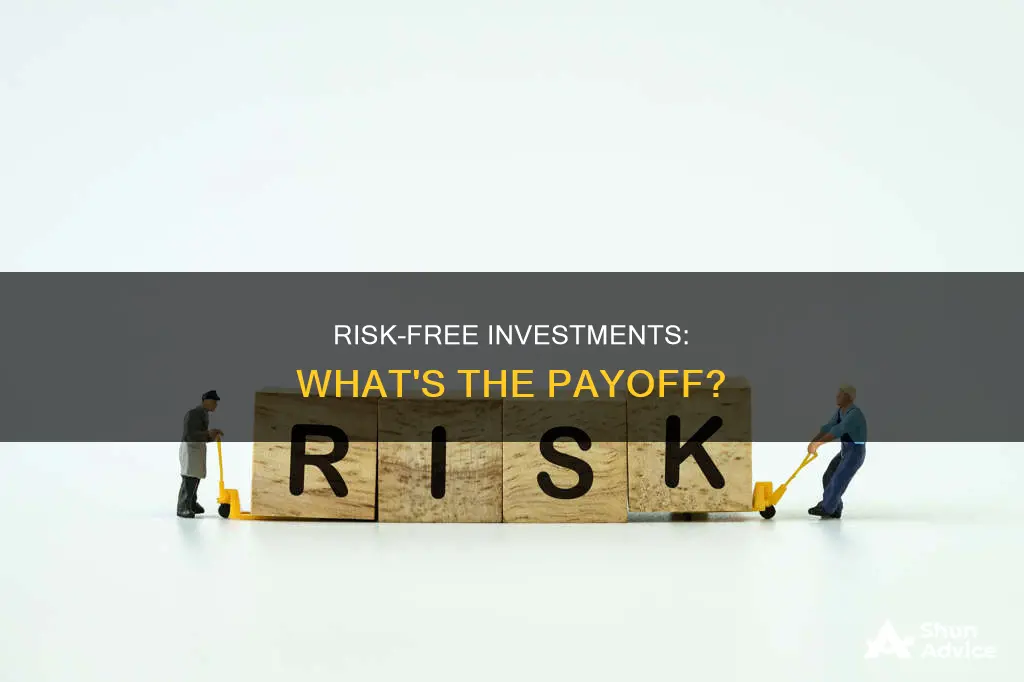
Risk-free investments are those that carry zero risk and have a certain future return. While technically all investments carry some form of risk, U.S. Treasury bonds are often used as the standard for risk-free assets. The probability of the U.S. government defaulting on its debt is considered very low, so investors view these bonds as safe investments. Risk-free assets tend to have low rates of return because their safety means investors don't need to be compensated for taking on risk.
| Characteristics | Values |
|---|---|
| Definition | A risk-free asset is one that has a certain future return and virtually no possibility of loss. |
| Examples | U.S. Treasury bills, notes, and bonds; short-term government treasury securities; cash or cash equivalents; high-yield savings accounts; money market funds; cash management accounts; dividend-paying stocks; money market accounts |
| Return | The risk-free return is the theoretical return attributed to an investment that provides a guaranteed return with zero risk. |
| Rate | The risk-free rate represents the interest on an investor's money that would be expected from a risk-free asset over a specified period of time. |
| Calculation | The "real" risk-free rate can be calculated by subtracting the current inflation rate from the yield of the Treasury bond matching the investment duration. |
| Benchmark | The risk-free rate serves as a fundamental building block in finance and provides a benchmark against which the return on all other investments is measured. |
| Use cases | Risk-free assets can be used as collateral in lending agreements, help financial services organisations meet financing and regulatory requirements, and inform individual investment decisions. |
What You'll Learn

Risk-free rate of return
The risk-free rate of return is the theoretical rate of return of an investment with zero risk. In other words, it is the minimum return an investor expects for any investment. In practice, a truly risk-free rate does not exist because every investment carries at least a small amount of risk.
The risk-free rate is important in finance as it is used as a baseline rate to compare the return on other investments. It is also used in financial modelling, investing, and valuations, as well as in pricing financial instruments. For example, it is used in the capital asset pricing model (CAPM), which is a widely used model for estimating the cost of equity. According to CAPM, the expected return of an asset is determined by adding a risk premium to the risk-free rate.
The risk-free rate can be calculated in different ways, depending on the specific investment and market conditions. In the US, the interest rate on a three-month Treasury bill is often used as the risk-free rate, as there is very little chance of the US government defaulting on its obligations. However, the risk-free rate varies across countries and currencies, depending on economic conditions, monetary policies, and geopolitical risk.
While there may not be any truly risk-free investments, there are some low-risk options available. These include high-yield savings accounts, money market funds, short-term certificates of deposit, cash management accounts, dividend-paying stocks, and money market accounts. These investments offer modest returns and are generally considered safe, but they may not always keep up with inflation, which can erode the purchasing power of your money over time.
Benefits of Hiring an Investment Manager for Your Money
You may want to see also

Risk-free assets
U.S. Treasury bonds are typically the go-to risk-free assets and are often used as a benchmark for other investments. The return on these assets is very close to the current interest rate because their safety means investors don't need to be compensated for taking a chance.
Other examples of risk-free assets include:
- Short-term government treasury securities such as Treasury bills (or T-bills)
- Central bank policy rates, such as the Federal Reserve's Federal Funds Rate in the U.S.
- Inflation-indexed bonds, such as Treasury Inflation-Protected Securities (TIPS) in the U.S.
- Cash or cash equivalents, such as money market funds or bank savings accounts, for very short-term investment horizons
It's important to note that while these assets are considered risk-free, they are not completely without risk. They are subject to reinvestment risk, which means that for a long-term investment to remain risk-free, any reinvestment necessary must also be risk-free. Additionally, the exact rate of return may not always be predictable for the entire duration of the investment due to changing interest rates.
Rajiv Gandhi Equity Savings Scheme: A Smart Investment Move
You may want to see also

Risk-free investments
US Treasury bonds, bills, and notes are often used as the standard for risk-free assets. The interest rate on a three-month US Treasury bill is commonly used as a proxy for the short-term risk-free rate. The large size and deep liquidity of the market contribute to the perception of safety. However, it's important to note that even these investments are not entirely risk-free, as inflation can erode their purchasing power over time.
Different countries and economic zones may use different benchmarks as their risk-free rate. For example, investors with assets in euros or Swiss francs may use German or Swiss government bonds as proxies. The general rule of thumb is to consider the most stable government body offering treasury notes in a certain currency.
While they may not be entirely risk-free, some other low-risk investments include high-yield savings accounts, money market funds, short-term certificates of deposit, cash management accounts, dividend-paying stocks, and money market accounts.
Understanding Managed Investments: What Are Listed Managed Investments?
You may want to see also

Risk-free rates
In practice, a truly risk-free rate does not exist, as every investment carries at least a small amount of risk. However, certain investments are considered to be very close to being risk-free, such as government treasury securities. These are often used as proxies for the risk-free rate in financial analysis and valuation.
The risk-free rate is important as it serves as a baseline rate in financial modelling, investing, and valuations. It is used to determine the present value of future cash flows and plays a part in cost-of-capital calculations. The risk-free rate also helps price financial instruments such as bonds, options, and derivatives.
For investors, the risk-free rate is significant as it helps them assess whether the potential return of an investment justifies the level of risk taken. It is also used in valuation models such as the capital asset pricing model (CAPM), where it is the baseline rate of return against which the expected returns of risky assets are compared.
The risk-free rate is influenced by various factors, including monetary policy decisions, economic conditions, inflation expectations, and market sentiment. It is also important to note that the risk-free rate can vary across different countries and currencies, reflecting differences in economic conditions, monetary policies, and geopolitical risk.
Smart Investment Decisions: Strategies for Success
You may want to see also

Risk-free assets and returns
Risk-free assets are investments that are considered to have a precisely known return and no possibility of loss. While all investments carry some degree of risk, the risk associated with these assets is so small that it is appropriate to consider them risk-free. The most common examples of risk-free assets are US Treasury bonds, bills, and notes, which are considered risk-free because they are backed by the "full faith and credit" of the US government. The return on these assets is very close to the current interest rate as their safety means investors don't need to be compensated for taking a chance.
Risk-free assets are important in the financial system and are used as benchmarks for other investments. For example, lenders looking for high-quality collateral might accept risk-free assets, and financial services organisations like banks might hold them to meet financing and regulatory requirements.
The risk-free rate of return is the theoretical rate of return of an investment with zero risk. It represents the interest an investor would expect from a risk-free investment over a specified period of time. In practice, a truly risk-free rate does not exist because every investment carries at least a small amount of risk. However, the interest rate on a three-month US Treasury bill is often used as the risk-free rate for US-based investors. The large size and deep liquidity of the market contribute to the perception of safety.
The risk-free rate serves as a fundamental building block in finance. It provides a benchmark against which the return on all other investments is measured. The risk-free rate is used in financial modelling, investing, and valuations, and it helps price financial instruments and determine appropriate rates of return for investment strategies. For instance, it influences the pricing of bonds, options, and derivatives as it is a key input in pricing models.
While risk-free assets are considered safe, they are not completely immune to risk. Over the long term, they may be subject to reinvestment risk. For a long-term investment to remain risk-free, any reinvestment necessary must also be risk-free. Additionally, the exact rate of return may not always be predictable for the entire duration of the investment due to changing interest rates.
Understanding Investment Management Fees: Cost Analysis
You may want to see also
Frequently asked questions
A risk-free investment is one that has a certain future return and no possibility of loss. While technically all investments carry some degree of risk, U.S. Treasury bonds are often used as the standard for risk-free assets.
The risk-free rate of return is the theoretical rate of return on an investment with zero risk. It is the minimum return an investor expects. In practice, it is often calculated using the interest rate on a U.S. Treasury bill.
The risk-free rate can be calculated by subtracting the current inflation rate from the yield of a Treasury bond that matches your investment duration.
Examples of risk-free investments include U.S. Treasury bills, notes, and bonds, as well as short-term government treasury securities such as T-bills or treasury bonds.
Risk-free investments provide a guaranteed return with zero risk. They serve as a benchmark for measuring the returns of other, riskier investments. They also help in financial modelling, investing, and valuations, and can be used as collateral or to meet regulatory requirements.







